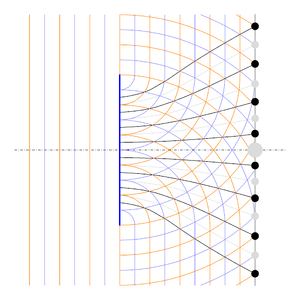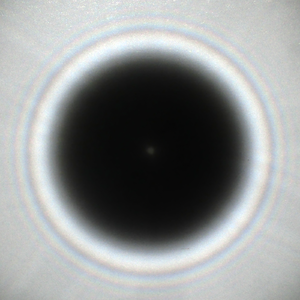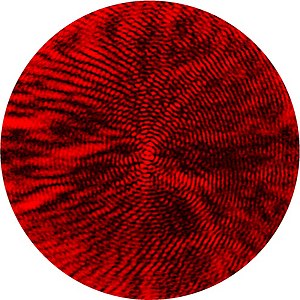Poisson stain
The Poisson spot is a diffraction phenomenon in optics and describes the bright spot in the center of a diffraction figure when light is diffracted by a rotationally symmetrical, opaque object.
Emergence
All points in a circle are equidistant from any point on the vertical axis through the center of the circle. With perpendicular illumination of the object, all elementary waves interfere constructively on the entire axis.
According to Huygens' principle , all spherical elementary waves emanating from an edge are superimposed so that they also spread in the geometric shadow behind opaque objects. This diffraction of light results in the superposition of all elementary waves to be considered, certain interference patterns that can be made visible on a suitable projection surface.
The wave fronts of the plane wave incident on a sphere (blue) from the left (the maxima and minima are shown in blue and orange respectively) are in phase on the central axis on the right behind the sphere and therefore interfere constructively, so that at every point on the axis, for example a light spot can be detected on a projection surface (light gray spot on the gray screen on the right).
The wave fronts of the plane wave incident on an opaque pane (blue) from the left (maxima and minima are shown in blue and orange respectively) cause spherical elementary waves at the edge of the pane, which are superimposed on the right behind the pane. The light gray lines and spots illustrate the locations with constructive overlay (same phase position) and the black lines and spots the locations with destructive overlay (anti-phase cancellation).
history
Many scientists of the 17th and 18th centuries, for example Isaac Newton , rejected a wave-theoretical consideration of light, as described for example by Christiaan Huygens around 1650. They assumed unchanged that light is a particle phenomenon whose trajectories could be described purely mechanically. The scientists at the time did not yet know that light can only be fully described if the quantum mechanical wave-particle dualism is taken as a basis.
In order to get closer to the theoretical causes of the various inexplicable optical observations, a competition was announced in 1818 by the French Académie des Sciences . The 30-year-old engineer Augustin-Jean Fresnel took part in this competition with a novel work on the wave theory of light. The jury, which also included Siméon Denis Poisson , was chaired by François Arago . Other jurors were the mathematician Pierre Simon de Laplace and the two physicists Jean-Baptiste Biot and Joseph Louis Gay-Lussac .
Poisson studied the work submitted by Fresnel, but was also convinced of the particle nature of light after reading it. With a simple thought experiment he tried to refute the validity of the Fresnel theory: According to his considerations based on the theory, light should be detectable in the center of the shadow behind a round, illuminated object, since the light from the entire circular edge of the obstacle according to the theory as Wave would interfere constructively there. Since experience has shown that this is obviously not the case, Fresnel's ideas would also be absurd. In doing so, Poisson consciously opposed the wave nature of light, as already described by Christiaan Huygens .
However, Arago decided to conduct this experiment under very precise conditions and was actually able to prove the existence of such a light spot by attaching a metal disk two millimeters in diameter to a glass plate with wax and illuminating it. This made a strong and convincing argument for the predicted wave nature of light, and to Poisson's chagrin, Fresnel eventually won the competition.
The phenomenon was already described by Joseph-Nicolas Delisle in 1715 and by Giacomo Filippo Maraldi in 1723 , but their works initially went largely unnoticed.
In English literature, the term Poisson's spot is used synonymously with Arago's spot .
Experimental setup
The Poisson spot P must be generated with a coherent light source so that the diffracted rays can interfere constructively. For example, the beam of a laser with the diameter or the beam of a small pinhole diaphragm with the diameter illuminated with white light can be used. This beam can be widened over the main plane H of a converging lens with a large focal length , so that a slightly divergent beam with the beam divergence is created behind the focal point F :
Behind the focal point F, an opaque sphere K with a very smooth surface and the diameter can be illuminated at a distance, which is projected onto a screen B at a distance behind the sphere. The diameter of the geometric shadow of the sphere on the screen is then and the diameter of the light beam . The following relationships exist between these quantities:
It follows:
The larger the distance b is selected, the fewer diffraction orders can be seen in the geometric shadow of the sphere on the screen, since the path differences between the light rays emitted from the edge of the sphere in the shadow area become increasingly smaller and therefore fewer interference maxima and minima in Fresnel diffraction occur.
example Pictures
Photograph of the diffraction pattern in the shadow of a sphere 10 millimeters in diameter in the light of a helium-neon laser with a Poisson spot in the center.
Web links
- Experimental arrangement and result . Ulm University, (Lecture Collection Physics).
- R. Gross: Diffraction and Interference . (PDF; 2.9 MB) In: Physics III. WS 2001/2002 & WS 2002/2003, Chapter 5, p. 207 f. (Lecture notes).
Individual evidence
- ^ A b Augustin-Jean Fresnel: Œuvres complètes d'Augustin Fresnel: Théorie de la lumière Imprimerie impériale, Paris, 1866 ( digitized in the Google book search).
- ↑ James Lequeux: François Arago: A 19th Century French Humanist and Pioneer in Astrophysics , Volume 421, Page 79, Astrophysics and Space Science Library, Springer, 2015, ISBN 9783319207230
- ^ Joseph-Nicolas Delisle: Reflexions In: Mémoires de l'Académie Royale des Sciences. 1715, pp. 166-169 ( digitized on Gallica ).
- ^ Giacomo Filippo Maraldi: Diverses expèriences d'optique In: Mémoires de l'Académie Royale des Sciences. Imprimerie impériale, 1723, pp. 111-142 ( digitized on Gallica ).



















